Townshend Audio Seismic Isolation Podium
Welcoming Good Vibes, Banishing Bad
Max Townshend was one of the most original and creative thinkers the world of high-end ever produced. Australian born and educated, he founded Townshend Audio in 1975. Among its initial products were a parabolic stylus for moving magnet pickups, one of the first moving coils to use a line-contact stylus, and the now near-legendary Rock turntables, which involved innovations in tuned suspensions and a thoroughly original way of damping resonances at the critical stylus/groove interface (a paddle attached to the head of the tonearm travelled across the record through a trough filled with viscous fluid). In 1978 he relocated to the United Kingdom, where he lived until his death, aged 78, on the last day of 2021.[1] He pioneered the use of cryogenics in interconnects and speaker cables, made speakers, and in the early aughts introduced the Allegri Reference, a passive linestage that may be the most beautiful sounding preamplifier I’ve ever heard.
But his most significant work, I think it’s safe to say, lies in the area of the effects of vibration and resonance on the reproduction of music in the home. He paid particular attention to the physical interface between audio components, notably speaker systems, and the floors of our listening rooms. This led him to develop a series of products called “Seismic Isolation,” which are designed to break the physical connection between speakers (and other components) and the floor. The most significant of these, and the subject of this review, is Townshend’s Seismic Isolation Podium for loudspeakers. In audio shows and conventions throughout the world he loved to demonstrate the effectiveness of the Podium by placing a pair of speakers side by side, one on its supplied spikes standing directly on the floor, the other on a Seismic Podium. On each was an electronic tablet running a seismographic application. Townshend delighted in showing how all manner of disturbances from foot stomps to knuckle raps, even the extremely low-level, constant background movement of the earth itself, disturbed the speaker on the floor while the other remained unperturbed on a Podium. Townshend made a video of one of these demonstrations.
Vibrations Good and Bad
Vibration is at once the friend and the enemy of us audiophiles and our obsessive pursuit of the best possible reproduction of music in our homes. Without good vibrations, like bow across strings, breath through reeds, or sticks on cymbals, all of which set air to vibrating, we would hear no music or any other sounds. But air, which science classifies as a mixture of gases, is an ecumenically accommodating conductor, as happy to groove to bad vibrations as to good. What are bad vibrations? Limiting the discussion to our listening rooms, the buildings that house them, and their proximate environments, they are innumerable and include refrigerators, washers, driers, and generators. Then there are the structures themselves, which are far worse than air when it comes to vibrating and transmitting vibrations: floors, walls, ceilings, furnishings, quite literally almost everything in the room. Next those vibrations that originate outside, like passing vehicles, including trucks, busses, planes, trains, automobiles, and every sort of heavy equipment. And let’s not forget the components themselves: like the air, the floors, the walls, the ceilings, the windows, all too happy to sing and dance to whatever vibes are passed through cabinets, chassis, cartridges, tonearms, plinths, platters, bases, transports, and speaker enclosures.
For the purposes of this review I am limiting myself to the vibrations that originate in or are otherwise produced by structures, in other words, the buildings that house our dwelling places. In the very early days of audio hardly any attention was paid to these sorts of disturbances apart from their effects upon turntables, which in the more serious cases of acoustic feedback are readily audible. Inasmuch as a turntable with arm and phono pickup is a transducer, any vibrations that reach the delicate stylus/groove interface have the potential to be reamplified back through the system; in the most severe cases, the reamplification forms a repeating loop that gets louder and louder until, left unchecked, the resulting howl blows out woofers and fries the voice coils of midranges and tweeters.
Feedback leading to acoustic breakthrough rarely reaches that level of destructiveness—never unless a turntable is involved. In most instances, the effects of unwanted vibrations are sufficiently low as to cause little obvious mischief, particularly when it comes to electronics, most audiophiles ignoring or choosing to live with them. With speakers they cover a wide range of sins, including but not limited to bass that is soft, somewhat lacking in definition and clarity, plummy, a mite bloated, even maybe a little muddy. Some of these effects migrate up into the lower midrange; further up the scale clarity and transparency are compromised; throughout the entire frequency spectrum, dynamic range and transient response suffer, not to mention detail and resolution, along with them precision of imaging and a solid, well-defined soundstage. Perhaps what is most pernicious about these effects is precisely that they are difficult to pin down, rarely gross, obvious, coarse, or crude, but nevertheless occasionally, or oftener, present enough to provoke that vague feeling of dissatisfaction that many audiophiles experience from time to time with their systems.
Historically, there are two basic ways designers and audiophiles have dealt (and continue to deal) with these: coupling and decoupling. In the former, components are coupled as rigidly as possible to the floor, generally by spikes. In decoupling, something “lossy” is placed somewhere in the mechanical path between the component and the floor, in order to break or otherwise compromise the rigidity of the connection to the room.
To Spike or Not to Spike
I’ve been an audiophile for over half a century and have tried both remedies, myriad variations and combinations of them, and a few dozen (maybe more) specific products like tips for spiking and rubber or polymer feet or discs for decoupling. But for quite a number of years I used spikes to make everything as rigid as possible. Why? Well, because that was the received wisdom, and also because what I now regard as hasty, superficial comparisons suggested it was the way to go. When you spiked a speaker you right away heard “improved” definition, transient response, tighter, supposedly better-defined bass. The theory seemed logical, indeed, unimpeachable: rigidly coupling the speakers, or any other component, to floor or cabinet isolated the component and provided a path for spurious resonances to be drained away and dissipated as heat in the larger mass of the cabinet or floor (eventually the ground). If the only point of contact is the sharpened tip, how could anything reflect back through them?
The answer is that any and practically everything could and did, since that one-way street turns out to have been two-way after all. This is because, as the audio consultant and writer Jim Smith once put it—freezingly, in my opinion—“Spikes are NOT loudspeaker isolation devices. They are tuning devices.”[2] I did not realize this for a long time. But what I did know is that after the initial putative “improvements” in, say, resolution, detail, transient response, bass definition, etc., I began to find the presentation subtly edgy, sometimes not so subtly, with a difficult-to-define loss of ease and relaxation, of musical warmth, naturalness, a certain organic musicality, an always welcoming listenability, that it had before, replaced by a low-level aggressiveness. Not suspecting it could be the rigid coupling—received wisdom is a formidable inhibitor of out-of-box thinking—I tried any number of ways to get rid of it. Some seemed to work very well (room treatment, for example), but still that residual edginess raised its irritating head from time to time.
I’ll not recount the whole odyssey whereby I began to think that rigid coupling was the problem, but it more or less began with a pair of stands for which the spikes were missing. Waiting for them to arrive, I set the stands on the carpet, situated the speakers on them, and proceeded to listen. Now, I’m not about to tell you I immediately heard a reduction in the edginess. Remember, the edginess was low level and vague. But I soon enough realized there was a new-found, or, rather, rediscovered sense of ease and relaxation to the presentation. I attributed this of course to the new stands—until the spikes arrived. Then, like a dutiful lemming, I screwed them in and prepared to be wowed by ever greater heights of resolution and depths of detail. Instead, what I heard, this time almost immediately, were those damned bad vibes again. Sometime later I switched out the spiked metal stands for open wooden stands that, while rigid, were not spiked, the uprights resting directly on the carpet, and lo and behold, back came those good vibes.
After several swings and roundabouts, I had pretty much consigned my pile of spikes, cones, tips, and other sorts of mechanical rigidifications to the attic. Not that I gave up, quite yet, on spikes, but if I used them for, say, stability on thickly carpeted or uneven floors, I made sure I put something lossy between the top of the stand and the bottom of speaker: rubber feet, sorbothane pads or pods, a healthy pellet of Blu-tack—hell, you don’t even need anything that fancy. An equipment reviewer I know had his carpenter build a sturdy utilitarian stand, made from nothing more pretentious than shop-grade two-by-fours and particle board, for his large three-way monitors; he put a thick towel on each platform and a speaker on the towel (that system, by the way, remains one of the half dozen or so finest I have ever heard anywhere).
If I have to place speakers directly on a hardwood floor, I substitute generic rubber feet for the spikes or else aftermarket decoupling discs with divots in them for the spikes, being sure, however, to use decouplers that have some sort of decoupling material under them (rubber, a polymer, felt, etc.).[3] If there isn’t, then I apply thick felt pads to them (these pads with adhesive backing are available in a variety of sizes, shapes, and thicknesses from your local home improvement store or Amazon). Jim Smith finds furniture sliders perfectly acceptable, and they’re certainly a good way to begin experimenting with alternatives or fixes to direct spiking and they also reap the considerable reward, as do felt pads, when the floor is hard (wood, tile, concrete) of making it so much easier to slide your speakers around for optimal placement and orientation.
The trouble, however, even with putting something lossy into the speaker/stand/floor connection is that it’s a decoupler that doesn’t truly decouple, thus truly isolate. In other words, there is a still a path for unwanted vibrations to reach your system, only a now less efficient one. But there is a third way: true isolation by way of high-pass filtering. The speaker or the speaker on its stand is placed on a platform with a tuned suspension, not dissimilar to the way some turntables are suspended from their bases on springs tuned to a very low frequency, typically around 3Hz. The tuning acts as a high-pass filter that prevents any frequencies above the tuning frequency from reaching the stylus/groove interface and thus banishes acoustic feedback as both problem and worry.[4] To my knowledge, there is only one manufacturer who has designed a series of products that make it possible for tuned suspensions to be added aftermarket to all the other components in a typical sound system, including, paramountly, loudspeakers.
Enter the Townshend Seismic Isolation Podium
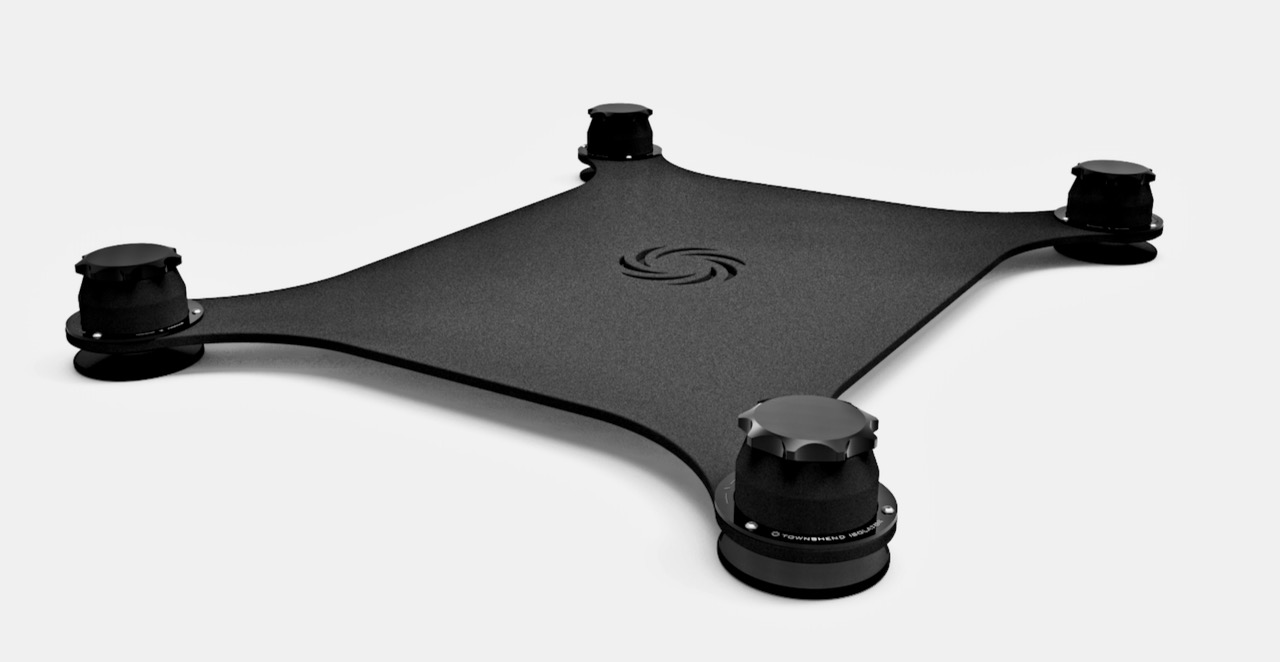
One of the things Max Townshend discovered in his experiments is that, just as with turntables, all the other components in an audio system, including and especially speakers, are also susceptible to feedback. This in turn suggested that the same solutions that are so effective for turntables, beginning with Edgar Villchur’s Acoustic Research AR XA in 1961 and continuing to the present day in products like the most of the SOTA, SME, and Basis turntables, might be equally effective with all the other components in a typical sound system: namely tuned suspensions. Thus was born the Townshend Seismic Load Cell™. According to the literature, each consists of an alloy steel compression spring surrounded by a flexible synthetic rubber jacket with two end plates. The cells allow free movement in all directions and are height adjustable. The tuning frequency is 3Hz and a “movement-sensitive, air-resistance damper rapidly dissipates low frequency oscillation caused by disturbing the suspended equipment.” The basic product is the Seismic Isolation Pod, an individual cell, sold in packages of four to be placed under components, replacing their supplied feet. Seismic Isolation Platforms consist in a steel plate with four pods attached to it and are intended for turntables that lack their own suspensions and also for larger, heavier electronics.
The Podium is basically a heavier-duty platform with a more elaborate pod assembly that allows for dual leveling. First, you level the platform by adjusting the feet (no level is supplied); then you place the speaker on the Podium and fine tune level if necessary via wheel-like knobs on top of each pod. The total height a Podium raises the speaker is only 0.75-inch. Podiums come in five different sizes, Models 1-5, with Load Cells™ keyed by color to weight ranges. Achieving the lowest possible tuning, which is desirable, requires springs suitable to the weight they have to bear. Since Townshend has done the calculating, you need only supply the weight and footprint dimensions of your speaker (including stands if required) and select the appropriate model. Weight ranges from 5kg to 200kg (11lbs to 440lbs) are accommodated, but the company says it can make (and has made) Podiums for speakers of any size and weight, including monster ones weighing several hundred pounds. Pricing ranges from $1300 to $2400 a pair, custom ones priced on application. My Harbeth Monitor 40.3 speakers, weighing a little over ninety pounds with TonTräger stands, required the Model 3 at $1700 a pair. These prices are not cheap, but Townshend products are very well made, exceptionally well-engineered, and work as claimed—formidably. The Podium improves the sound in almost every way that you can imagine.
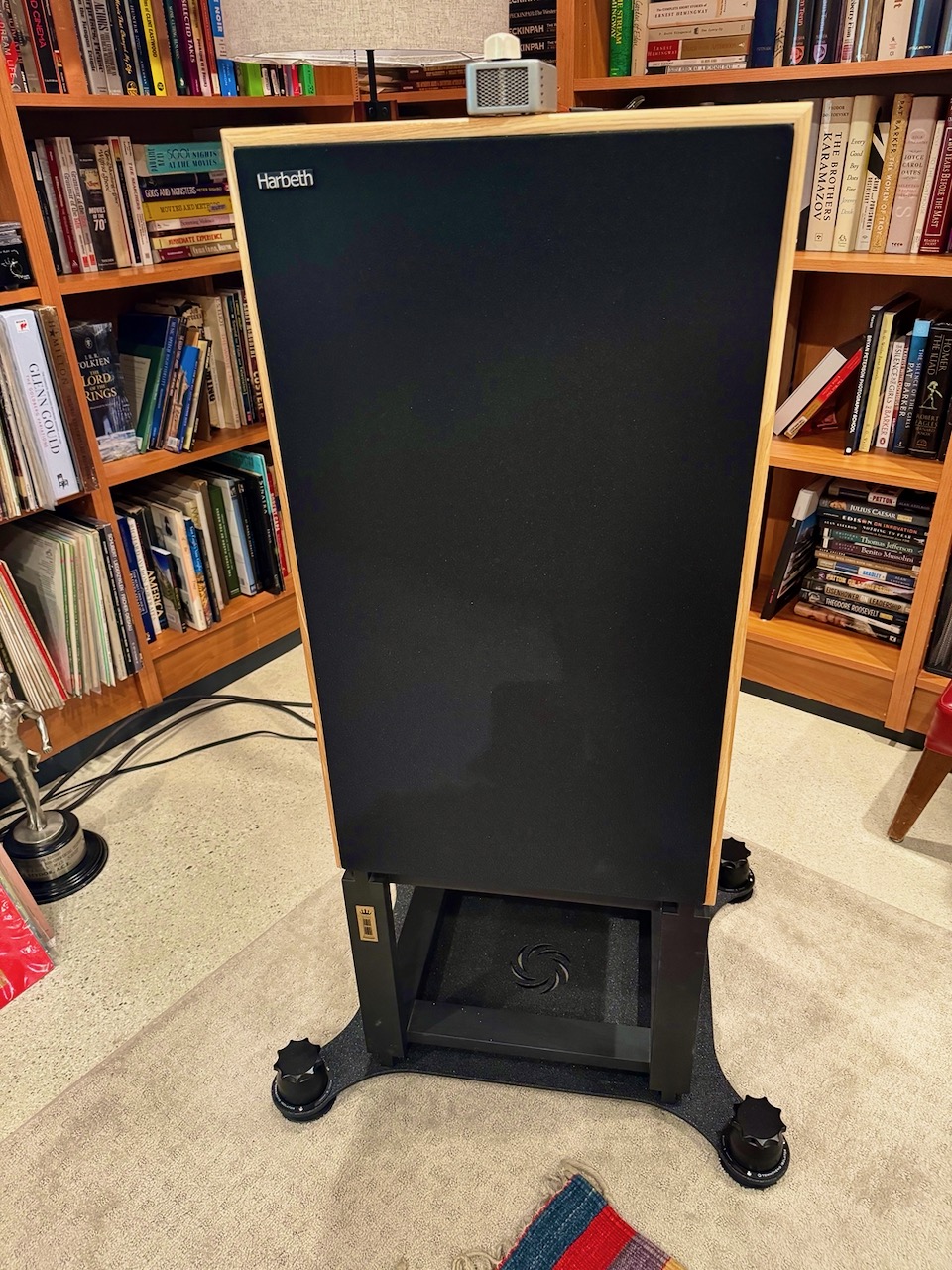 Townshend Audio Podium under Harbeth Monitor 40.3 XD loudspeakers on TonTräger stands (Townshend Maximum Ribbon Supertweeter atop Monitor 40.3)
Townshend Audio Podium under Harbeth Monitor 40.3 XD loudspeakers on TonTräger stands (Townshend Maximum Ribbon Supertweeter atop Monitor 40.3)
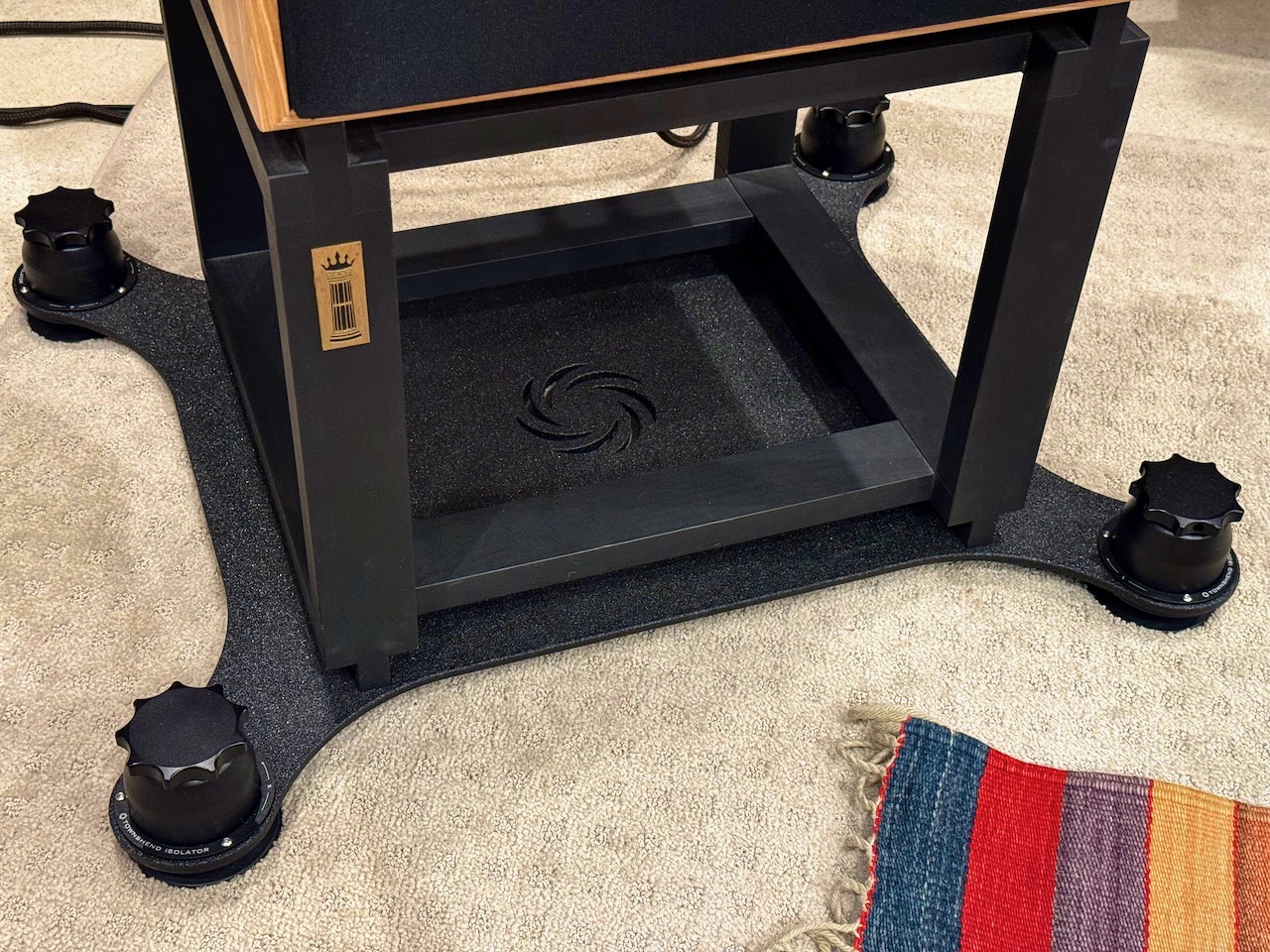 Transient Response, Coherence, and Flow
Transient Response, Coherence, and Flow
I begin with this because so strong is the bias in favor of spiking that the first time many audiophiles see a Podium in action they reject it out of hand. Touch the speaker, give it an ever so slight nudge, and it starts to move or, rather, to rock, bounce, or sway gently and slowly. This can’t be right, surely—a speaker is supposed be planted rigidly, "unbudgeably" in place, not least so the box doesn’t respond, Newton-like, with an equal and opposite reaction to the sound the woofer reproduces, thus dulling transients, blurring definition, reducing clarity, and muddying bass. This is one of those canards that has been allowed to exist as long as it has mostly because its “wisdom” is so rarely examined, let alone challenged. In the video previously referenced, Townshend points out that if a typical woofer cone weighs about 40 grams and a typical cabinet 40kg, the cone movement will be a thousand times greater than the cabinet movement, which means that you lose about 1/1000th of the intensity of the music or 0.01dB. As a point of reference, the lowest difference the ear can discern is 0.1dB on pure tones; at least 2-3dB are required for music or other normal sounds; 0.01dB is not an audible difference.
My experience indicates the Podiums actually improve transient response because, once isolated from the floor, the speaker doesn’t become a tuning fork set off by the vibrations returning from the floor. No longer enhanced by resonances that spikes excite, transients of things like cymbal taps and drum hits, triangles and plucked strings, sound far closer to the real thing. Check out the wood blocks on Sonny Rollins’s Way Out West that really sound like wooden blocks. If you happen to have The Sheffield Drum Test Record, still astonishing after all these years, listen to how really clean the drum kit sounds from top to bottom under a Podium and then listen without the Podium. Next more over to a real torture test: the three virtuoso guitarists on Impex’s Saturday Night in San Francisco—don’t just listen for the transient response, listen to how natural the guitars sound and how dimensional.
Three additional points. First, if the drivers in your speakers are really well matched, then perceived coherence—that is, the sense that instruments retain their tonal character as they pass from one driver to another and that the sound is arriving together in time—is improved. Second, also improved are the music's flow and connectedness, which are obviously compromised when the reproduction is constantly disrupted by vibrations and resonances extrinsic to the source. Third, once situated, my Harbeths, mounted on their TonTräger stands, are extremely difficult to move around on the Podium platform. In other words, the speakers stay securely where you place them with no worries about their reacting deleteriously against the sound waves they generate.
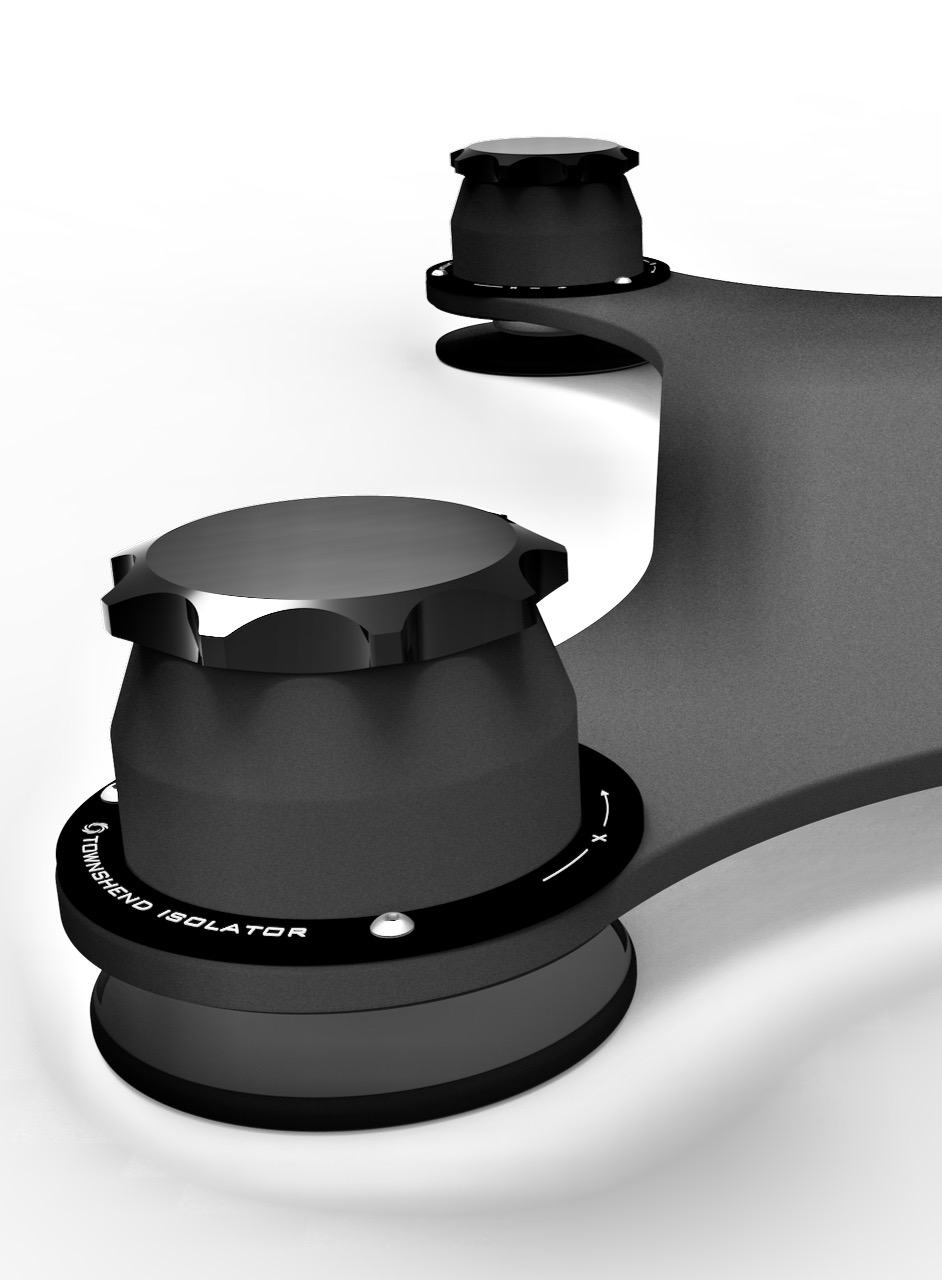 Detail of cell/foot: adjustable feet below the platform for leveling the Podium by itself; wheeled knob atop cell for fine tuning level once speaker is in place
Detail of cell/foot: adjustable feet below the platform for leveling the Podium by itself; wheeled knob atop cell for fine tuning level once speaker is in place
Noise Floor and Dynamic Range
I group these together because each relates to the other. A wide dynamic range is considerably less effective if the noise floor is high; while a low noise floor is always desirable, if you can’t play your music loud enough when it demands to be loud, then it’s kind of academic. Owing to their function as high-pass filters, Seismic Podiums clean up the sound to a quite amazing degree, beginning with the bass frequencies, which are not only better defined, more detailed and articulated, they are also fuller, richer, and appear to go deeper. Inasmuch as the floors are no longer vibrating your speakers, these virtues extend to the upper frequencies as well: clarifying the fundamental frequencies, and reducing them where appropriate, also in effect clarifies the overtones. At the same time, however, you no longer get that excessively tight bass that many audiophiles seem to like but that I’ve never experienced in any live musical performance. You might initially feel that you’re getting less ample bass than before. This is because you probably are, except that a lot of that ample bass was a function of resonances reinforcing themselves over and over. The rightness of bass response with the Podiums is limited only by the limitations of the recordings, your speakers and other components, and your room. Put on either the DG Original Source Series vinyl reissue of the great William Steinberg/Boston Symphony Also Sprach Zarathustra, or Zubin Mehta’s Los Angeles Philharmonic Decca recording, and just listen to how clean, defined, and deep that opening 32-foot pedal point really is.
Imaging and Soundstaging
These things depend primarily on how recordings are miked and mixed, only secondarily on the components that reproduce them. Of course, that “secondarily” bulks very large. When the whole presentation is purged of spurious resonances and unwanted vibrations so that it is reproduced against a really clean and quiet background, precision of imaging and stability of soundstage will follow as surely as morning the night. One of my reference recordings is the Bernstein Carmen (DG, vinyl and Blu-ray audio); go to act IV (side 6) to hear opera staged for the microphone in such a way that the whole world of the drama is realized in sound alone: the city square outside the bull ring full of hucksters selling their wares, the milling crowd cheering the arrival of the matador and his entourage, a children’s chorus marching in and out, eventually the matador entering the ring while the rejected, humiliated Don Jose turns up for the final confrontation with Carmen. It is all staged and reproduced as an integral space that is solid and three-dimensional, with remarkable verisimilitude that a good system will reveal in all its flesh and blood immediacy. The bass on this recording can be a little on the whompy side, but since it’s no longer exacerbated by vibrations you don’t want, the effect is greatly reduced. The dynamic range is huge, huger still with the Podiums than before (I’ve been using this recording as a reference since it was first released in the early seventies).
Holographic imaging is something we reviewers like to talk about, but again, its realization depends first upon the recording, then the equipment. The Norwegian label 2L records in churches and similar venues in such a way as to capture the ambience of the venues. The miking is a bit distant, but not too much, so that on a good system the best of these recordings really do conjure spaces with richly reverberant acoustics and musicians performing in those places. I’d recommend An Old Hall Ladymass with the Trio Mediaeval, Of Innocence and Experience (piano pieces by Beethoven, Liszt, and Schumann), and Polarity (a jazz group). Another recording engineered from the outset to capture the sound of a musical event in an actual venue where it might be performed is the recent Chandos complete Oklahoma! (see my Tracking Angle review), recorded in a real theatre with minimal miking and very little gain riding (maybe none once levels were set). Sit back, close your eyes, and you’re transported to the ideal seat in an actual theatre. What all of these recordings do, especially with Podiums isolating your speakers from the floor, is allow your system to come very, very close to Peter Walker’s ideal of a truly transparent sound: a window onto the concert hall.
Tonal Balance, Disappearing Speakers, and Disappearing Rooms
As is frequently not the case with spikes, decoupled or no, Podiums don’t alter the tonal balance of the speaker. ln fact, with the effects of external vibrations effectively eliminated, your speakers will sound more like themselves than before. This is because one prominent effect mentioned by several reviewers is that the speakers seem to disappear as sources. I agree except that I think this states what’s actually happening wrong way round. What the Podiums do is reduce to an extraordinary, maybe even unprecedented degree the effects of the room as a vibrating structure or complex of vibrating structures on the speakers themselves. When an audio consultant friend of mine who specializes in optimizing the speaker/room relationship, with particular attention to the bass, heard the Podiums in my room, the first thing he observed was that they seemed to reduce the negative contributions of the room. In other words, to his ears, the room was doing the disappearing act, not the speakers. A large beneficial consequence of which is a greater openness, as if the entire presentation had shed itself of a certain restraint and constriction.
Resolution, Detail, and Flow
I’ve already adduced many examples of improved detail and resolution, not to mention definition and clarity. But I give them their own heading here in order to reinforce the point that the improvements brought about in these areas by the Podiums do not come at the expense of excessive or other artificially highlighted detail. The detail that I hear with the Podium sounds completely natural and in just proportion to the rest of the presentation. As is not the case with spikes, there is no transient enhancement, while ringing or other untoward effects are greatly reduced when they are not eliminated entirely. As for that elusive impression of musical flow and connectedness, obviously this is compromised by constant disruption owing to vibrations and is preserved when those vibrations are prevented from reaching the loudspeakers.
Accessory or Necessity?
The effectiveness of the Podiums, and all the other Seismic products, will vary from room to room and system to system, but I’ve yet to find an instance where the improvements they make are not substantial. This is as true, by the way, for poured concrete floors as for wooden suspended ones. I have two listening rooms. The one in the house has a wooden suspended floor, the one in my new office (a garage conversion) a concrete slab. The improvements brought by the Podiums are about equal in both rooms, just as Townshend demonstrates in his video with the seismographic apps. And because the biggest contribution of unwanted vibrations is from the floor and the speaker/floor interface, a pair of Podiums will also result in improved performance from all your components, especially your record playing setups if the plinths aren’t on tuned suspensions.
Setup is fairly straightforward and easy, though if your speakers are heavy and or/large, a second pair of biceps is advised.[5] Truth in reporting requires I note that two cells in one of the Podiums arrived not working, that is, they were frozen and would not loosen up. Replacements followed and all was well (though changing out a cell is a real pain). You know when they’re not working because once set up and the speaker positioned, if the speaker is nudged, all four cells should move freely as if floating and then come to a quick rest.
By way of wrap up, allow me to put this review in perspective: no accessory I’ve ever purchased in my several decades as an audiophile—no tips, spikes, pucks, pods, pads, bricks, blocks, stands, platforms, weights, dampers, certainly no wire products of any sort including line conditioners and filters—has brought the transformative improvements that the Podiums have, and with absolutely no negative consequences. When Neil Gader, my colleague at The Absolute Sound, reviewed the Podiums, he concluded, “Townshend’s Seismic Isolation Podiums registered on my own personal Richter Scale like few so-called ‘accessories’ I’ve ever experienced.” Those quotation marks around “accessories” were intended, Neil told me, to suggest the Podium is something of greater importance than a mere accessory. I concur completely but will state it less elegantly: for me, they are not accessories, but necessities that will remain a permanent fixture in any serious sound system I have. I’m already exploring the possibility of a set custom made for my QUAD ESL-57s!
Notes
[1] See tributes by Robert Greene in The Absolute Sound and David Price in stereonet
[2] “Spiking Your Speakers: What’s the Point?” (Copper no. 39: posted 8 August 2017): Smith is also the author of a really useful book called Get Better Sound: not a consumer guide, rather a series of steps and procedures anyone can use to improve the sound of a system they already have, no matter how modest, with particular emphasis on the speaker/room relationship.
[3] There are dozens of decoupling discs and gliders with divots for the spikes on the market, available from online (including Amazon) to specialty audio dealers. One brand that keeps coming up is Herbie’s Audio Lab, which offers a variety of products very reasonably priced. I’ve never used them but on the strength of recommendations from some industry professionals I find always reliable, I plan to investigate them.
[4] I assume no one reading this needs to be told that tuning the suspension of a platform that supports a loudspeaker is an entirely different thing from the tuning effects that spiking has on the speaker itself.
[5] Should you retain spikes on the Podiums? Your call. But if I kept them, I’d be sure to put decoupling discs under them so as not to mar the finish of the platform. (TonTräger stands are not spiked.)
Specifications
Podiums are available in five versions; weight, size, and price ($1300-$2400/pr) vary with model.
Manufacturer Information
Townshend Audio
Importer: EAR-USA
Attn: Dan Meinwald
562 / 422–4747
Email: info@ear-usa.com


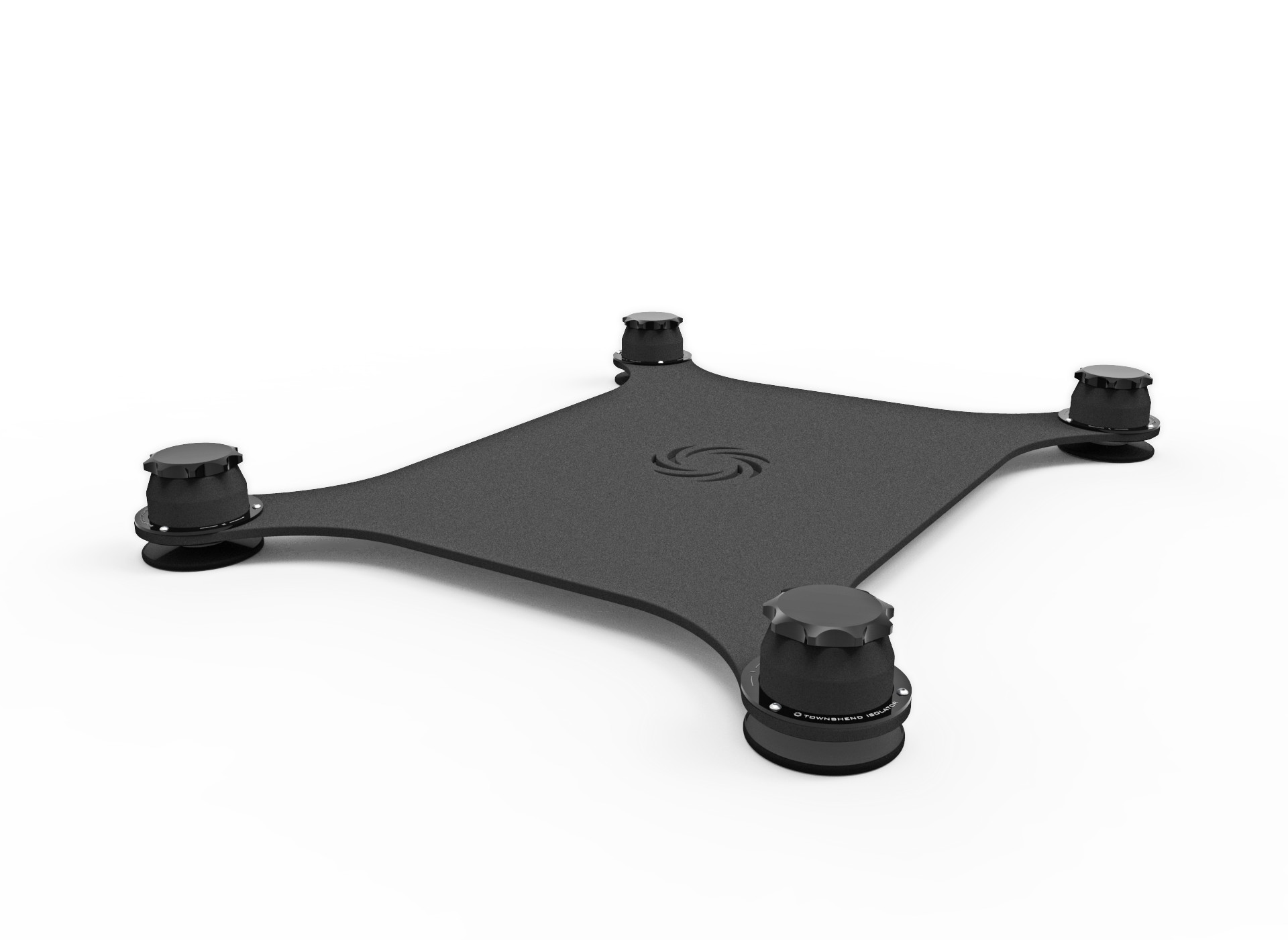







































.png)








